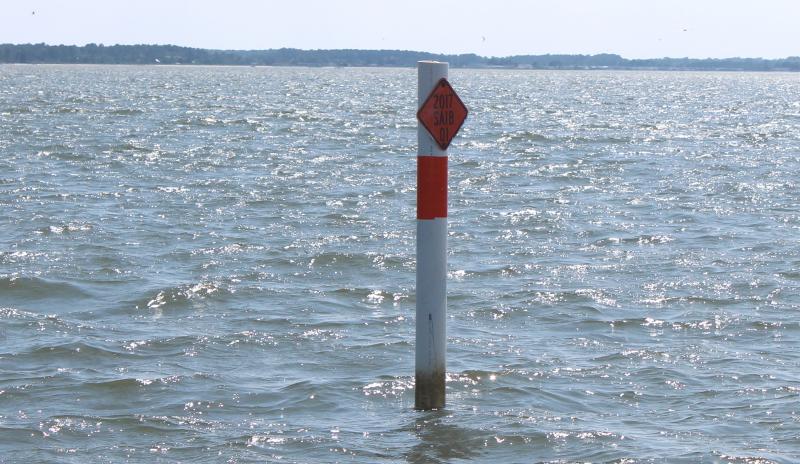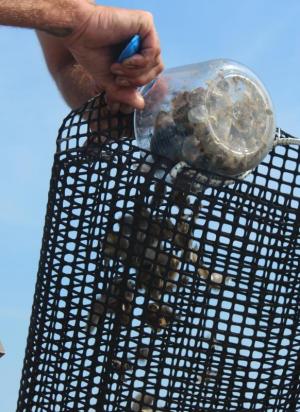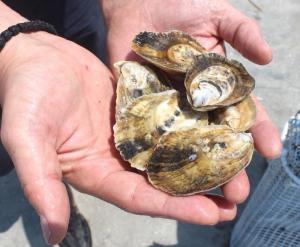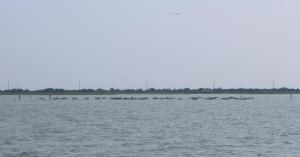Aquaculture programs, practices vary from state to state
Editor’s note: This is the third in a series of stories about shellfish farming in Delaware’s Inland Bays. After years of developing and passing regulations, farming has begun and the first oyster cages are now in the water. In the coming months, reporter Chris Flood will explore the ins and outs of the new industry.
When Chris Redefer plunged his oyster cages into Rehoboth Bay earlier this summer, Delaware became the 22nd state, and the last one on the East Coast, with a state-authorized commercial aquacultural program.
Delaware Department of Natural Resources and Environmental Control scientist Zina Hense said a lot of research went into creating the state’s regulations, but no single state was used as a model. She said states have varied water features and environments.
“It’s not a cookie-cutter practice by any means,” said Hense, who has been DNREC’s main point of contact for concerned citizens and potential farmers through the years-long process.
Hense said no one knew how many acres people would apply for. She said the state was looking for the program to start, and then it would go from there.
Bob Rheault, East Coast Shellfish Growers Association executive director, said he is skeptical of Delaware’s program. It’s almost like the state doesn’t want the industry to succeed, he said.
Rheault said he began farming the waters off Rhode Island in 1986, before selling his farm eight years ago to have a more active role in the growers association. Delaware is not yet a member of the East Coast Shellfish Growers Association, he said, because there have to be three grower members, and that requirement hasn’t been met yet.
Rheault said many states have looked to Rhode Island as a model for how to make regulations. He said one problem with Delaware regulations is too much equipment is needed to mark each acre of farm area. In Delaware, all four corners of a leased acre must be marked with PVC piping that can easily be seen at high tide.
“Let's make it as unsightly as possible from the get-go,” he said. “It’s extremely expensive and way overkill. In Connecticut, they use bamboo poles to mark the leases.”
Hense said the state chose PVC markers for precautionary measures. Many Inland Bays users are not familiar with the navigation channels, and public safety was a large concern, she said.
“The PVC pipes were based on a recommendation from enforcement,” she said.
Susan Bunsick, NOAA Fisheries Office of Aquaculture policy analyst, said Delaware’s program is relatively new, so it is premature to draw conclusions on how effective and efficient it will turn out to be in comparison to other states on the East Coast.
NOAA recently completed a comprehensive study of all the programs across the country. Bunsick said access to this information enables stakeholders at the federal, state, and local levels to learn from one another, and, she said, it can be used to develop more effective and efficient permitting systems for shellfish aquaculture.
Bunsick said this study was the first time NOAA funded such a comprehensive look at shellfish permitting around the country. A common challenge for both commercial production and restoration activities, she said, is navigating complex regulatory systems, which vary around the country and involve many different agencies, laws, and regulations.
“Our goal is to increase populations of bivalve shellfish in our nation’s coastal waters – including oysters, clams, and mussels – through both sustainable commercial production and restoration activities,” Bunsick said. “As part of the National Shellfish Initiative, NOAA encourages similar efforts at the state and regional level.”
Bunsick said state-to-state differences in permitting been an issue for years. She said one goal of the study was to find ideas that seem to work well in multiple states and therefore are good practices for other interested states to consider adopting.
“The interagency permit review team in Washington and eight other states is a good example,” she said.
Bunsick said she would look first to neighboring states to learn.
“Maryland has greatly expanded the number of commercial shellfish leases in recent years. Virginia has a long-established history of shellfish farming. New Jersey shares a water body – the Delaware Bay,” she said. “Delaware can learn from what works in these nearby states and perhaps avoid some issues these other states may have encountered along the way.”
Rheault said there can be a gold rush mentality when it comes to shellfish farming. He said there will be a market for some farmers, but then more people will get into the business, and the prices will collapse if the local market isn’t big enough to support them all. It’s important for the farmers to expand their markets, he said.
Rheault also said the gold rush mentality can lead to people who don’t care about the water getting involved in the industry. It’s a privilege to do this type of work, and there’s a responsibility to not make it a mess, he said.
“In a nutshell,” Rhealt said. “Don’t break the laws, and don’t get people sick, or any successes can come crashing down in one big heap.”
Hense said she expects the program to evolve over coming years as more acreage is leased and best practices for aquaculture across the country become common practice. There’s a lot of reading, studying published research and looking for innovations, she said.
“There’s all kinds of stuff,” she said.
Comparison of East Coast aquaculture programs
In June 2018, National Oceanic and Atmospheric Administration released a comprehensive evaluation of the 22 states with shellfish aquaculture permitting processes. The following is a brief summation of the states along the East Coast.
According to that report, 90 percent of the seafood consumed in the country is imported.
“While U.S. aquaculture production is increasing, there remain significant bureaucratic and social constraints. Unless these can be addressed, our nation’s dependency on imported seafood will only increase as the U.S. population grows from 321 million 2015 to 398 million by 2050,” the report says. Other findings in the report are:
• All states require a production report. Delaware and Massachusetts are the only ones identified as requiring a monthly report of planting, harvest and estimated value.
• All the states allow leases to be transferred. In Florida, it’s allowed after the initial five-year period.
• nine states require a business plan and a management plan. Delaware is the only one identified as having significant documentation requirements.
• Maryland is the only state that doesn’t have any acreage limits.
• Every state but Georgia has a fee. There is also a $100 fee due to the Army Corps of Engineers in most states. In Delaware, that fee is waived if the lease is inside a Shellfish Aquaculture Development Area.
• Permit review/approval time frame: No matter the state, In all states getting an aquacultural permit takes time. The typical approval time ranges from 6 months to a year for Massachusetts, Rhode Island, New Jersey, Maryland, New York and Florida. There was no estimate available for Delaware.
• All states have a renewable term limit for leases: The difference is in the length of the leases – 10 years in Maine, 15 years in Rhode Island, 3 years in Connecticut. Leases in Delaware are renewable annually for 15 years.
• Most states require no leaseholder training or exam requirement. Rhode Island requires training. North Carolina has an exam requiring at least a 70 to pass.
The number of shellfish applications in the last 3 to 5 years in each state varies. There have been 7 to 10 applications in Maine, while Virginia has had 300.
The number of leases in the last 3 to 5 years in each state varies greatly. In Florida, there have been 609 leases. In New Jersey, there have been 930. According to the DNREC interactive map, in Delaware there are three leases.
Along the East Coast, thousands of leaseholders/individuals are employed in aquaculture. Florida, Massachusetts, New Jersey, Virginia and Connecticut all employ more than 300 people in aquaculture.
Still in its fledgling stages, a number of the states report farm gate value estimates in the millions. Maine had $6 million in 2016. Massachusetts reported $25.4 million in 2013. Connecticut doesn’t specify a year, only that $30 million has reported.
Chris Flood has been working for the Cape Gazette since early 2014. He currently covers Rehoboth Beach and Henlopen Acres, but has also covered Dewey Beach and the state government. He covers environmental stories, business stories and random stories on subjects he finds interesting, and he also writes a column called Choppin’ Wood that runs every other week. He’s a graduate of the University of Maine and the Landing School of Boat Building & Design.



























































